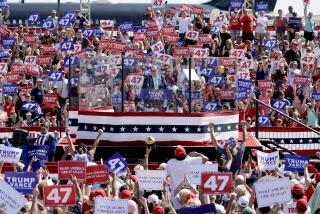Total of PACs Giving Election Funds Declines
- Share via
WASHINGTON — After a decade of uninterrupted growth, the number of political action committees that contribute money to candidates for public office declined during the 1989-90 election cycle, the Federal Election Commission announced Saturday.
Even though the decline coincides with growing criticism of the role of PACs in American politics, there is no evidence that they are disbanding in response to their critics. Instead, the decline appears to be caused largely by the collapse of the savings and loan industry and a nationwide downturn in the success of direct-mail fund-raising appeals.
The FEC said that there were 4,681 PACs operating in the last election, reflecting a decline of 151 from the previous election cycle.
Although the money raised by PACs also declined about 3%, that had no apparent impact on the flow of contributions to candidates. The FEC reported that PACs contributed about $159 million to federal candidates in the last election--about the same amount contributed in 1987-88.
Steven Stockmeyer, executive vice president of the National Assn. of Business Political Action Committees, noted that the growth in PACs had been tapering off ever since the mid-1980s. But he said he knew of only one company--Centel Corp. of Chicago--that had folded its PAC in response to what he called “PAC bashing.”
Michael Waldman, campaign finance expert for Public Citizen’s Congress Watch, suggested that the decline may reflect an increased tendency among corporate executives to write personal checks to candidates instead of relying on the corporate PACs. By bundling together dozens of personal checks of up to $2,000 from corporate executives, a company can give more to a candidate than a PAC, which is limited to $10,000.
Many of the PACSs that disbanded during the last election cycle had been sponsored by the savings and loan industry. Not only have many thrifts been shut down by the government over the past few years, but many candidates have returned contributions of savings and loan PACs in order to avoid being blamed for the industry’s collapse.
Much of the decline in PAC fund raising during the past two years also was attributed to the difficulty that many ideological groups have encountered in using direct mail to raise money for political candidates. Virtually all direct mail enterprises have reported declining success rates in recent years.
The biggest decline in receipts was reported by the National Security Political Action Committee, which raised only $1 million in the last election cycle compared to $10.3 million in the 1987-88 campaign.
In 1989-90, ideological PACs made contributions to candidates of $15.6 million, or 22% of their total receipts, their highest percentage during the past decade. Meanwhile, corporate PACs contributed $58 million to candidates, or 58% of their receipts; labor PACs contributed $34.7 million, or 41%, and trade association PACs contributed $44 million or 51%.
The one PAC that raised and spent the most money during the last election was the Teamsters’ Democratic Republican Independent Voter Education Committee, which reported total receipts and expenditures of about $10.5 million. But the biggest contributor to federal candidates was the Realtors Political Action Committee, with contributions totaling $3 million.
The AT&T; PAC dominated all corporate political action committees by raising $2.8 million. The American Medical Assn. PAC surpassed all other trade associations in fund raising by collecting $5.7 million.
More to Read
Get the L.A. Times Politics newsletter
Deeply reported insights into legislation, politics and policy from Sacramento, Washington and beyond. In your inbox twice per week.
You may occasionally receive promotional content from the Los Angeles Times.










